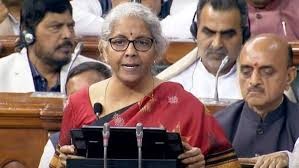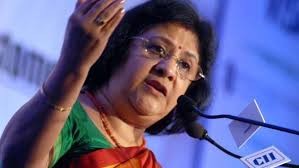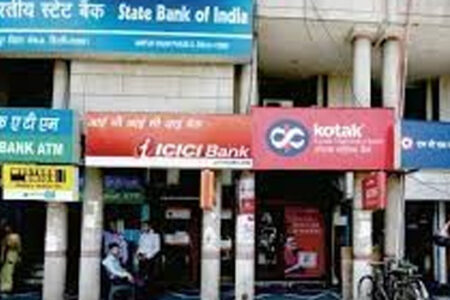When it comes to banking, the Union Budget often bites off more than it can chew.
For instance, in the first Budget of the century, on February 29, 2000, then Finance Minister Yashwant Sinha made a big-bang announcement of bringing down the government holding in public-sector banks to 33 per cent.
Let me quote from his speech:
“The recent East Asian crisis has underlined the critical importance of undertaking reforms to strengthen the banking sector… (The) government have (sic) decided to accept the recommendations of the Narasimham Committee on Banking Sector Reforms for reducing the requirement of minimum shareholding by government in nationalised banks to 33 per cent. This will be done without changing the public-sector character of banks and while ensuring that fresh issue of shares is widely held by the public… (The) interests of the employees of the nationalised banks will be fully safeguarded.”
It didn’t happen. Instead, one-and-a half-decade later, the government has gone for consolidation of the sector, bringing down the number of such banks.
Fast forward to February 2021.
Finance Minister Nirmala Sitharaman read out her speech: “In spite of Covid-19, we have kept working towards strategic disinvestment. A number of transactions namely BPCL, Air India, Shipping Corporation of India, Container Corporation of India, IDBI Bank, BEML, Pawan Hans, Neelachal Ispat Nigam Limited among others would be completed in 2021-22. Other than IDBI Bank, we propose to take up the privatisation of two public-sector banks and one general insurance company in the year 2021-22. This would require legislative amendments and I propose to introduce the amendments in this session itself.”
In the previous year, her Budget had said, “In the last few years, the government has taken concrete steps to bring our banking system to be robust. However, there is a need for greater private capital. Accordingly, it is proposed to sell the balance holding of the Government of India in IDBI Bank to private, retail and institutional investors through the stock exchange.”
(In all three quotes, the italics are mine.)
The privatisation of two-public sector banks and even that of IDBI Bank continue to remain on the drawing board.
Life Insurance Corp of India (LIC) is slated to sell 30.24 per cent in IDBI Bank, bringing down its stake to 19 per cent, and the government plans to sell 30.48 per cent, paring its stake to 15 per cent. After the sale, the combined stake of LIC and the government will drop from 94.72 per cent to 34 per cent, passing on 60 per cent to the new owner, making it a truly private bank. Is this happening? If yes, when?
On March 17, 2023, Department of Investment and Public Asset Management (DIPAM) Secretary Tuhin Kanta Pandey tweeted: “Reports appearing in a section of the media indicating the possibility of deferment of IDBI Bank disinvestment are misleading, speculative and baseless. The transaction continues to be on track as per the defined process in the post-EoI stage following receipts of multiple EoIs.”
(EoI refers to expressions of interest. DIPAM manages government holding in public-sector enterprises.)
This was the last time we heard about IDBI Bank privatisation. How long will the post-EoI stage last? Which two public-sector banks will be privatised? Your guess is as good as mine — about both the identities of the two banks as well as the time of privatisation. With elections round the corner, it’s unlikely that the interim Budget will speak on this.
So, what can the banking sector expect from this Budget?
For sure, the finance minister will continue to walk on the fiscal consolidation path. The last Budget, besides sticking to the 6.4 per cent estimated fiscal deficit of FY23, charted out the fiscal glide path by pegging fiscal deficit at 5.9 per cent in FY24, paring it by 50 basis points (bps). One bps is a hundredth of a percentage point. The finance minister also reiterated her comment to bring down the fiscal deficit below 4.5 per cent by FY26.
Weaker nominal gross domestic product (GDP) growth, shortfall in disinvestment target and higher subsidy spend will be balanced out by higher tax revenue, and dividend from the Reserve Bank of India (RBI) and public sector undertakings. Following this, the fiscal deficit is expected to be contained at 5.9 per cent of GDP in the current year. For FY25, the estimated fiscal deficit is likely to be 5.3-4 per cent.
Depending on the inflow of tax revenue, it can be further cut to 5.2 per cent in the Budget to be presented after elections. An average 70 bps cut a year will bring down the fiscal deficit to 4.5 per cent by FY26.
The treasury managers of banks are keen to know how much the government will borrow next year. Keeping in mind the fiscal deficit figure, in the current year, the gross market borrowings are estimated at ~15.4 trillion, and, net of redemption, the net borrowing at ~11.8 trillion — the highest-ever government borrowing programme. In the next year, it could be marginally less — around ~15.1/2 trillion and ~11.5 trillion, respectively.
(Gross borrowing could be less if the RBI goes for “switches” or replaces certain shorter duration government bonds due for redemptions with longer duration papers — something which it has done in the current year.)
Incidentally, in FY20, the gross borrowing of the government was ~7.1 trillion. It almost doubled to ~13.7 trillion in FY21. The next year, it dropped to ~11.3 trillion but rose to ~14.2 trillion in FY23. If we include the current year’s estimated borrowing (~15.4 trillion), in four years since FY21, the total government borrowing is to the tune of ~54.6 trillion — more than the total outstanding borrowing of the government towards the end of the last decade.
Of course, if we consider redemptions, the net borrowing amount is less. But then, there are state development loans (SDL). From ~6.08 trillion in FY20, SDL rose to ~7.78 trillion in FY21. The figures for FY22, FY23 and FY24 are ~6.71 trillion, ~7.17 trillion and ~10.88 trillion (indicative), respectively.
As the merchant banker of the government, the RBI has steered through the massive borrowing programme during the pandemic and after that with great finesse. It has not bought any government bonds through open market operations since September 2021, burdening its own balance sheet. At the same time, it didn’t allow the bond yields to zoom, shooting up the government’s cost of borrowing and hurting banks’ profitability.
On the last day of FY20, the 10-year bond yield was 6.14 per cent. Since then, in the past three years, it peaked at 7.62 per cent (on June 16, 2022) and a low of 5.78 per cent (July 10, 2020).
With India’s inclusion into the JP Morgan Emerging Market Bond Index, starting in June, there won’t be any let-up in demand for bonds. In fact, it will rise. So the bond yield will drop, making the bankers happy.
If the rate cut cycle starts in the second half of the financial year, we may see the 10-year bond yield dropping below 7 per cent. Last week it closed at 7.17 per cent. The market has nothing to worry about.
With the inclusion in the global index, the government doesn’t need a captive buyer for the sovereign bonds anymore. Let’s hope that encourages it to get back to the path of banking reforms in the post-election Budget.
This column first appeared in Business Standard.
The writer, Senior Adviser to Jana Small Finance Bank, is a Consulting Editor with Business Standard.
Writes Banker’s Trust every Monday.
Latest book Roller Coaster: An Affair with Banking
Twitter: TamalBandyo
Website: https://bankerstrust.in



